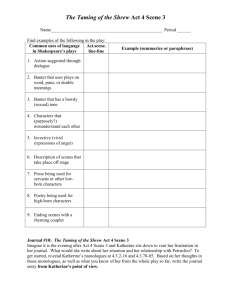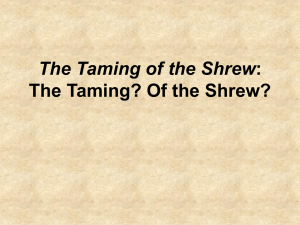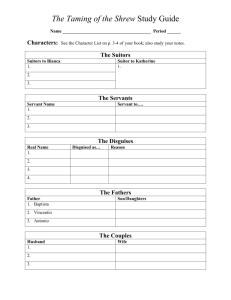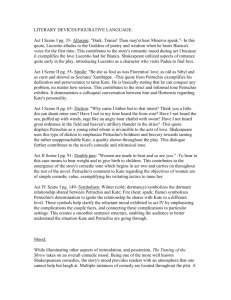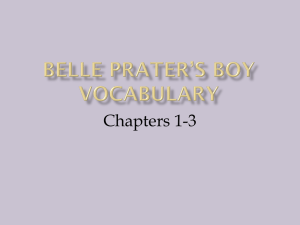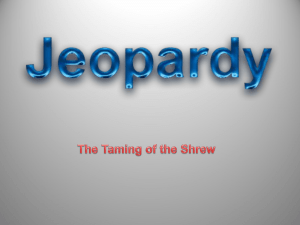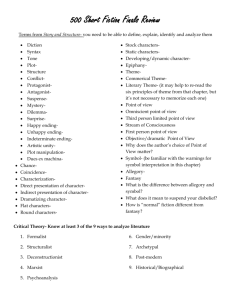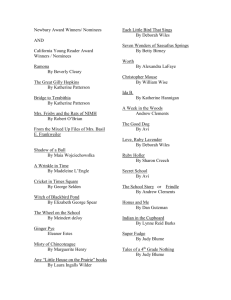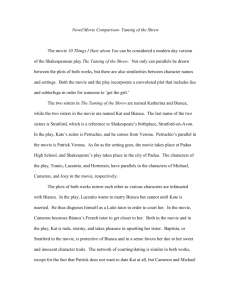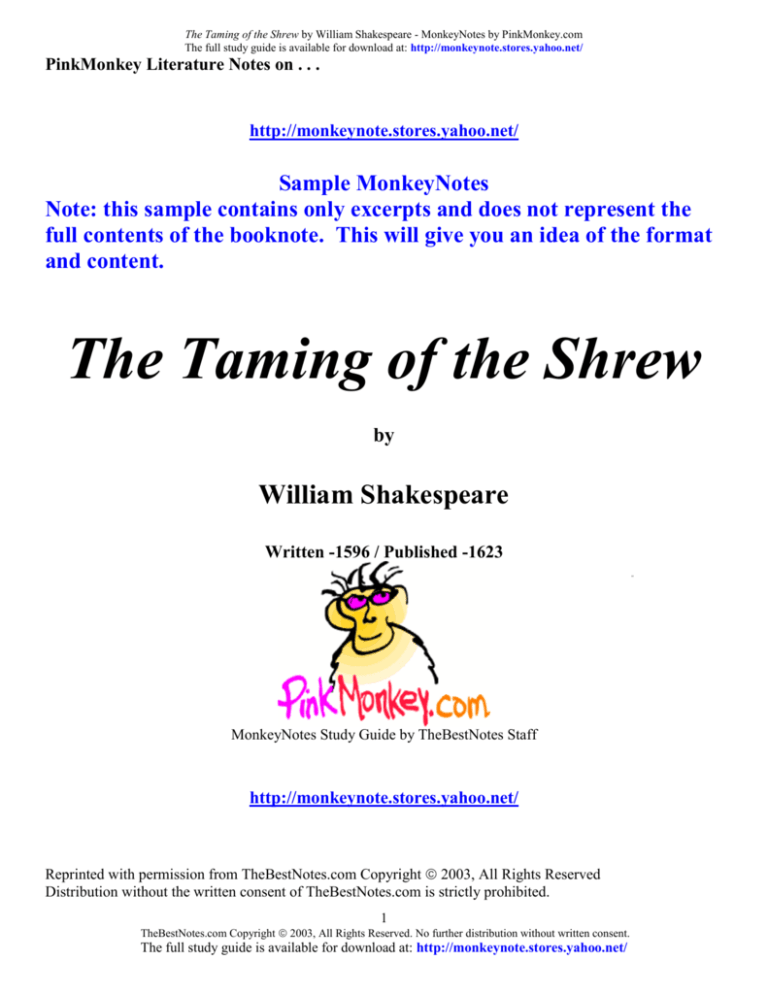
The Taming of the Shrew by William Shakespeare - MonkeyNotes by PinkMonkey.com
The full study guide is available for download at: http://monkeynote.stores.yahoo.net/
PinkMonkey Literature Notes on . . .
http://monkeynote.stores.yahoo.net/
Sample MonkeyNotes
Note: this sample contains only excerpts and does not represent the
full contents of the booknote. This will give you an idea of the format
and content.
The Taming of the Shrew
by
William Shakespeare
Written -1596 / Published -1623
MonkeyNotes Study Guide by TheBestNotes Staff
http://monkeynote.stores.yahoo.net/
Reprinted with permission from TheBestNotes.com Copyright 2003, All Rights Reserved
Distribution without the written consent of TheBestNotes.com is strictly prohibited.
1
TheBestNotes.com Copyright 2003, All Rights Reserved. No further distribution without written consent.
The full study guide is available for download at: http://monkeynote.stores.yahoo.net/
The Taming of the Shrew by William Shakespeare - MonkeyNotes by PinkMonkey.com
The full study guide is available for download at: http://monkeynote.stores.yahoo.net/
KEY LITERARY ELEMENTS
SETTING
The play is set mainly in the city of Padua, Italy, in various locations. The outside framework of the play,
known as Sly’s story or the induction, takes place at an alehouse and the Lord’s house. The play within a play
begins in Padua in a public place, where several scenes takes place. In Padua, there…..
CHARACTER LIST
Major Characters
Katherine - the protagonist of the play and the shrew referenced in the title. She is the daughter of Baptista and
the older sister of Bianca. She has no suitors because of her plain appearance and shrewish nature.
Bianca - Katherine’s younger sister. She has many suitors due to her attractive appearance and personality.
She is her father’s favorite and liked by everyone for her kind behavior. She falls in love with and marries
Lucentio.
Petruchio - a gentleman from Verona who marries Katherine because of her large dowry. After his marriage,
he sets in motion a plan to end Katherine’s scornful and unpleasant nature.
Lucentio - a young man from Pisa who falls in love with Bianca. He poses as Bianca’s tutor, wins her heart,
and elopes with her. After their marriage, the young couple receives the blessings of both Baptista and
Vincentio.
Vincentio - father of Lucentio.
Baptista Minola - a very rich gentleman of Padua. He is the father of Katherine and Bianca. He always favors
Bianca, who has a mild and pleasant nature. Throughout the play, he fails to show his affections for Katherine,
the older shrewish daughter.
Minor Characters
Hortensio - one of Bianca’s many suitors. He poses as her music tutor and hopes to…..
CONFLICT
Protagonist - Katherine is the protagonist of the drama and the shrew that is referenced in the play’s title.
Since she is not attractive and resents her father’s lack of attention, she has developed a……
Antagonist - Katherine’s antagonist is her shrewish nature, which she seems incapable of controlling. Since
she does not change of her own accord, Petruchio, her new husband, decides to change or….
Climax - The climax occurs in Act IV, Scene 5 when Katherine’s tamed personality is clearly revealed for the
first time. On the way to Padua for a visit with Baptista, Katherine docilely agrees with everything her husband
says. When Petruchio calls the sun the moon, Katherine agrees with him and calls it……
Outcome - The play ends in comedy, for Katherine, with the help of Petruchio, is finally able to control her
shrewish behavior. As a result, she becomes a gentle and pleasant young lady and…..
Subplot - There is also a subplot in the play where Lucentio is the protagonist. His antagonist is to win the
hand of Bianca in marriage. His plot ends in comedy with his marriage to Bianca …..
2
TheBestNotes.com Copyright 2003, All Rights Reserved. No further distribution without written consent.
The full study guide is available for download at: http://monkeynote.stores.yahoo.net/
The Taming of the Shrew by William Shakespeare - MonkeyNotes by PinkMonkey.com
The full study guide is available for download at: http://monkeynote.stores.yahoo.net/
SHORT PLOT SUMMARY (Synopsis)
The first act opens with Christopher Sly, a poor, drunken man, arguing with the hostess of the Alehouse. A
lord, returning from his hunt, stops at the Alehouse and decides to play a trick on him. He orders his servants to
take Sly to his house and dress him up in fine clothes. When he wakes up, the Lord, along with his servants,
convinces Sly that he is a nobleman who has lost his mental balance for fifteen years. The Lord invites a
company of traveling players to put on a show for Sly. The play is The Taming of the Shrew, which takes place
in the city of Padua, Italy.
Baptista Minola is an old, rich man with two daughters, Katherine and Bianca. He is anxious to marry them off
and offers a large dowry for each of them. Lucentio, a young man from Pisa, arrives in Padua with his two
servants,Tranio and Biondello. Lucentio falls in love with Bianca, Baptista’s younger daughter, and wishes to
marry her. Bianca, however, cannot marry until her older sister Katherine has found a husband.
In addition to Lucentio, Bianca has many other suitors, including Grumio and Hortensio. Since Hortensio is in
a hurry to have Bianca for his wife, he tries to find a suitable mate for ……
THEMES
Major Theme
The major theme of the play is the unpleasant and hurtful nature of shrewish behavior. Ironically, it is not just
Katherine that demonstrates such unpleasant ways. Baptista treats his oldest daughter rudely, which causes
Katherine to hide her hurt by acting more scornfully and violently. Petruchio is intentionally cruel and hateful
to teach his wife a lesson for her own good. The servants are cruel to……
Minor Theme
The minor theme of the play is appearance vs reality. Throughout the drama, things are never really as they
seem. Katherine appears to be a real shrew, but it is all a cover-up for the hurt she feels. Bianca appears to be a
self-sacrificing angel, but she is really a spoiled young lady who can quickly revert to……
MOOD
Overall, the mood of this comedy is quite light. Most of the time, in spite of Katherine’s shrewish nature, the
drama is comic, with Petruchio’s exaggerated behavior and with the many…….
BACKGROUND INFORMATION - BIOGRAPHY
William Shakespeare is usually considered the greatest dramatist and finest poet the world has ever known. No
other writer’s plays and poetry have been produced so many times or in so many countries or translated into so
many languages. One of the major reasons for Shakespeare’s popularity is the variety of rich characters that he
successfully creates, from drunkards and paid murderers to princes and kings and from inane fools and court
jesters to wise and noble generals. Each character springs vividly to life upon the stage and, as they speak their
beautiful verse or prose, the characters remind the viewers of their own personalities, traits, and flaws.
Shakespeare also made his characters very realistic. The dramatist had an amazing knowledge of a wide variety
of subjects, and his well-developed characters reflect this knowledge, whether it be about ……
LITERARY BACKGROUND
The Taming of the Shrew, written around 1596, first appeared in print in The First Folio of 1623. The play’s
theme of disciplining a headstrong wife is an old one. “A Merry Jest of a Shrewd and Curst Wife Lapped in
Morel’s Skin for her Good Behavior” was a folk ballad of the mid-sixteenth century; it told the story of
‘taming’ a wife in a brutally violent manner. Shakespeare, on the other hand, presents the……
3
TheBestNotes.com Copyright 2003, All Rights Reserved. No further distribution without written consent.
The full study guide is available for download at: http://monkeynote.stores.yahoo.net/
The Taming of the Shrew by William Shakespeare - MonkeyNotes by PinkMonkey.com
The full study guide is available for download at: http://monkeynote.stores.yahoo.net/
HISTORICAL INFORMATION
The play is set in the mid-sixteenth century in Italy (Padua) and reveals many things about the Italian patriarchal
society, where power and control rested solely with the male. The Italian man had great freedom, including the
freedom to mistreat his wife verbally, emotionally, and physically; on the other……
SCENE SUMMARIES WITH NOTES AND ANALYSIS
INDUCTION-SCENE 1
Summary
The opening scene of the play begins with Christopher Sly, a drunken tinker. He has an argument with the
hostess of an alehouse in Padua, Italy. She wants him to pay for some glasses he has broken, but Sly argues
with her and claims that his ancestors came with ‘Richard Conqueror’. She leaves to call the constable on him,
and Sly falls asleep.
A Lord and his attendants, on their way back from a hunting outing, spot Sly and decide to play a joke on him
for their own amusement. The Lord instructs his men to carry Sly into a nice room and dress him in fancy
clothes. When Sly wakes, they plan to tell him he is really a nobleman suffering from a mental disorder. They
also will tell him he has a wife.
A group of traveling actors arrive. They are hired by the Lord to perform for his men and for the drunken Sly.
The Lord warns the players that “Lord Sly” has never seen a drama performed, so he may have some strange
reactions. The Lord also pays Bartholomew, one of the pages, to dress up like a lady and pretend to be Sly’s
wife. The scene ends when the Lord leaves to watch the result of his trickery.
Notes
The induction creates the framework for the play. Christopher Sly has passed out at the alehouse from drinking
too much. When the Lord sees his inebriated state, he decides to play a joke on him. Sly is carried away,
dressed in fine clothes, and told he is a nobleman with a wife.
When the group of traveling actors arrive on the scene, the Lord asks them to present a play for Christopher Sly.
The play that is presented is The Taming of the Shrew.
The wealthy and witty Lord is not vitally important as a character, for he has only a few lines; however, he is
instrumental in transferring Sly to his chamber and creating some hilarious scenes. Sly is much more important
to the play as a whole. In spite of having relatively few lines in the first scene of the induction, his character is
firmly established. He is a tinker by trade who drinks excessively and acts like a clown. He also seems to be a
troublemaker, for the hostess of the alehouse goes to call the constable on him. Although he appears to be poor
since he is low on money, he humorously states that he is a descendant of “Richard Conqueror” (meaning
William the Conqueror). He also shows off by mumbling foreign words. Finally, he is gullible enough to fall
for the trick that the Lord is playing on him.
Shakespeare takes the framework of his play directly from the original The Taming of a Shrew; but in the
original, the characters from the induction are seen more often as they interact with the actors throughout the
play. In the end of the original play, Sly is carried back to the alehouse, where he awakes and thinks he has had
a dream about taming a shrewish woman. In Shakespeare’s play, the characters from this scene appear only
once after the Induction. Critics disagree on the effectiveness of Shakespeare’s framework. Some feel that Sly
should be a character throughout the play. Others feel that if Sly and the Lord were placed at the end of the
play, it would be anticlimactic and distracting. Others think that there was originally a final scene where Sly
was brought back, and it was lost before the play was printed.
4
TheBestNotes.com Copyright 2003, All Rights Reserved. No further distribution without written consent.
The full study guide is available for download at: http://monkeynote.stores.yahoo.net/
The Taming of the Shrew by William Shakespeare - MonkeyNotes by PinkMonkey.com
The full study guide is available for download at: http://monkeynote.stores.yahoo.net/
INDUCTION - SCENE 2
Summary
When Sly awakens, the Lord, dressed as a servant, joins his men in convincing Sly that he is a Lord with a wife
and that he has been insane for fifteen years. In the beginning, Sly is confused and says “call me not honour nor
lordship”; but he is soon convinced of his nobility when he sees servants surrounding him and offering all
manner of food and drink. Then, the “wife” (a page dressed as a female) is brought in to Sly. When Sly
observes how she seems to have missed him, he suggests they go off to bed. She excuses herself by saying that
the doctor has advised against it. A messenger then comes on stage to inform Sly that the company of players is
anxious to entertain him. He invites his wife to sit next to him during the play.
Notes
At first, Sly does not accept the story about his being a Lord; but once he is convinced, he begins to act
differently. He starts assuming airs, and his language changes from prose to poetry; his actions, however, still
betray the reality of his background. With the opportunity to order any drink he desires, he asks for the smallest
pot of ale.
Sly’s change in nature is a foreshadowing of Katherine’s own change. Like Sly, she begins with undesirable
traits, but during the course of the play, she begins to act less like a shrew and more like a noble and gentle
woman. For Katherine, however, her change will be permanent, for she has found the reality of who she is; for
Sly, his change is a temporary and fleeting one imposed as a joke. The scene is filled with dramatic irony, for
the audience is fully aware of the trick being played on Sly while he is sucked into it. As a result, his already
humorous utterings seem even more light and humorous.
Many critics believe that the induction is more than a play within a play or a simple introduction to the main
action. In truth, the induction seems very realistic in contrast to the dream-like quality of the play itself. In
fact, Sly questions if he is dreaming and then answers, “I do not sleep; I see, I hear, I speak, I smell sweet
savours.” As a result, Shakespeare seems to be saying that life itself is really just a dream with a small
framework of reality surrounding it; the audience or the reader is made to question what reality really is…….
OVERALL ANALYSES
CHARACTER ANALYSIS
Katherine/Kate - When the play begins, Katherine is perceived as a shrew. She is rude, critical, scornful, and
insulting. Since no one escapes from her temper and unpleasant behavior, she is strongly disliked by everyone,
including her father, who sees her as a burden. Since she feels deprived of Baptista’s affections due to his
favoritism towards her younger sister, Katherine adopts her unruly behavior to…..
Petruchio - Petruchio is a gentleman from Verona who is intelligent and witty. At the beginning of the play, he
is also portrayed as a greedy man who will do anything for money. He decides to marry Katherine for her large
dowry before he has ever met her. When he hears that she is a shrew, he is not ……
Bianca - Bianca, Katherine’s younger sister, pretends to be gentle, kind, helpless, and selfless. In truth, she is a
hypocrite and a manipulator who manages to conceal her true self until the end of the play. Throughout the
drama, she turns on her charm and seems to be loving and thoughtful in order to……
PLOT STRUCTURE ANALYSIS
The Taming of the Shrew is written in five acts that follow the traditional pattern for dramatic presentations. It
begins with an induction (introduction) which sets up the reason for having the play. In the first act, all the
characters are introduced and the plots of both the main plot and the subplot are established. In Acts II and III,
5
TheBestNotes.com Copyright 2003, All Rights Reserved. No further distribution without written consent.
The full study guide is available for download at: http://monkeynote.stores.yahoo.net/
The Taming of the Shrew by William Shakespeare - MonkeyNotes by PinkMonkey.com
The full study guide is available for download at: http://monkeynote.stores.yahoo.net/
the action of the main plot is developed as Petruchio and Katherine are married and his plan to tame her is put
into action. The subplot between Bianca and Lucentio is also……
THEMES - THEME ANALYSIS
Major Theme
The major theme is the hurtful nature of cruel behavior. Babtista is a cruel father, who makes Katherine’s life
miserable by antagonizing and humiliating her. He treats her unfairly, while favoring and spoiling her younger
sister, Bianca. Katherine reacts by becoming a shrew to hide her hurt and to seek revenge. She inflicts her ill
temper on everyone who crosses her path, striking servants, tying up her sister, and complaining about
everything to anyone who is willing to listen. Petruchio decides to marry Katherine for the large dowry
Baptista has given her. As soon as he makes his decision, he implements a……
Minor Theme
The minor theme is appearance vs reality. Throughout the play, no one seems to be what they claim to be or
what they project themselves to appear. Bianca seems to be a modest and mild young lady; in truth, she is a
spoiled girl capable of shrewish behavior. Kate is perceived to be…..
STUDY QUESTIONS
1. There is a play within a play in The Taming of the Shrew. Explain what this means.
What is the main plot of the play? What is the subplot of the play? How are they related?…..
END OF SAMPLE MONKEYNOTES EXCERPTS
http://monkeynote.stores.yahoo.net/
Copyright ©2003 TheBestNotes.com.
Reprinted with permission of TheBestNotes.com. All Rights Reserved.
Distribution without the written consent of TheBestNotes.com is strictly prohibited.
6
TheBestNotes.com Copyright 2003, All Rights Reserved. No further distribution without written consent.
The full study guide is available for download at: http://monkeynote.stores.yahoo.net/

